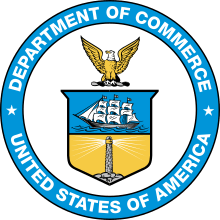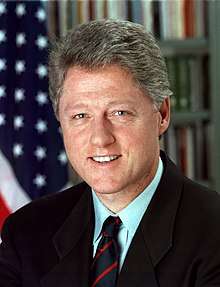Ron Brown
Ronald Harmon Brown (August 1, 1941 – April 3, 1996) was an American politician. He served as the United States Secretary of Commerce during the first term of President Bill Clinton. Prior to this he was chairman of the Democratic National Committee (DNC). He was the first African American to hold these positions. He was killed, along with 34 others, in a 1996 plane crash in Croatia.
Ron Brown | |
|---|---|
| 30th United States Secretary of Commerce | |
| In office January 22, 1993 – April 3, 1996 | |
| President | Bill Clinton |
| Preceded by | Barbara Franklin |
| Succeeded by | Mickey Kantor |
| Chair of the Democratic National Committee | |
| In office February 11, 1989 – January 21, 1993 | |
| Preceded by | Paul G. Kirk |
| Succeeded by | David Wilhelm |
| Personal details | |
| Born | Ronald Harmon Brown August 1, 1941 Washington, D.C., U.S. |
| Died | April 3, 1996 (aged 54) near Dubrovnik, Croatia |
| Resting place | Arlington National Cemetery |
| Political party | Democratic |
| Spouse(s) | Alma Arrington |
| Children | 2 |
| Education | Middlebury College (BA) St. John's University, New York (JD) |
| Military service | |
| Allegiance | |
| Branch/service | |
| Years of service | 1962–1967 |
| Rank | |
| Battles/wars | Vietnam War |
Early life and political career
Ron Brown was born in Washington, D.C., and was raised in Harlem, New York, in a middle-class family. He was a member of an African-American social and philanthropic organization, Jack and Jill of America. Brown attended Hunter College Elementary School and Rhodes Preparatory School. His father managed the Theresa Hotel in Harlem, where Brown lived growing up. His best friend John R. Nailor moved into the penthouse while a student at Rhodes. Nailor was one of the other few black students who attended Rhodes Prep. As a child, Brown appeared in an advertisement for Pepsi-Cola, one of the first to be targeted specifically towards the African-American community.[1]
While at Middlebury College, Ron Brown became the first African-American member of Sigma Phi Epsilon, collegiate fraternity. Brown joined the United States Army in 1962, after graduating from Middlebury, and served in South Korea and Europe, the same year he married Alma Arrington. After being discharged in 1967, Brown joined the National Urban League, a leading economic equality group in the United States. Meanwhile, Brown enrolled in law school at St. John's University and obtained a degree in 1970.
Rise in the Democratic Party

By 1976, Brown had been promoted to Deputy Executive Director for Programs and Governmental Affairs of the National Urban League. However, he resigned in 1979 to work as a deputy campaign manager for Senator Edward M. Kennedy, who sought the Democratic Party's presidential nomination.
Brown was hired in 1981 by the Washington, D.C., law firm Patton Boggs as a lawyer and a lobbyist.
In May 1988, Brown was named by Jesse L. Jackson to head Jackson's convention team at the Democratic National Convention in Atlanta. Brown was named along with several other experienced party insiders to Jackson's convention operation. By June, it was apparent that Brown was also running Jackson's campaign.[2]
Chair of Democratic National Committee
Brown was elected chairman of the Democratic National Committee on February 10, 1989, and played an integral role in running a successful 1992 Democratic National Convention and in Bill Clinton's successful 1992 presidential run.
Secretary of Commerce
President Clinton then appointed Brown to the position of Secretary of Commerce in 1993. Clinton's highest priority was bolstering the economy, not diplomacy, and Brown produced results. He led delegations of entrepreneurs, businessmen and financiers to South Africa, Mexico, Saudi Arabia, Jordan, Israel, the West Bank, Gaza, Egypt, Russia, Brazil, Argentina, Chile, China, Hong Kong, Ireland India and Senegal. He was leading a trade mission en route to Yugoslavia when all passengers died in a plane crash.[3]
During his tenure Brown was involved in the Commerce Department trade mission controversy.
Death

On April 3, 1996, when Brown was 54 and on an official trade mission, a U.S. Air Force CT-43 (a modified Boeing 737) carrying Brown and 34 other people, including New York Times Frankfurt Bureau chief Nathaniel C. Nash, crashed in Croatia. While attempting an instrument approach to Dubrovnik's Čilipi airport, the airplane crashed into a mountainside. Everyone aboard was killed instantly except Air Force Tech. Sgt. Shelly Kelly, a flight attendant, who died while being transported to a hospital.[4] The final Air Force investigation attributed the crash to pilot error and a poorly designed landing approach.[5] Speculations as to the circumstances surrounding the plane crash that caused Brown's death include many government cover-up and conspiracy theories, largely based on Brown having been under investigation by independent counsel for corruption.[6] Of specific concern was a trip Brown had made to Vietnam on behalf of the Clinton Administration. Brown carried an offer for normalizing relations between the United States and the former communist enemy.
Some people, including Kweisi Mfume - head of the NAACP at the time - and Rep. Maxine Waters (D-CA), chairwoman of the Congressional Black Caucus, had written federal officials to ask for more data on the suspicious circumstances of Brown's death. "Responding to homicide allegations, an official of the Armed Forces Institute of Pathology acknowledged that doctors initially were puzzled by a circular wound on the top of Brown's head when his remains were recovered at the crash scene. The forensic pathologist then consulted with others and took extensive X-rays. As a result of these consultations and full-body X-rays, we absolutely ruled out anything beyond a blunt-force injury to the head."[7]
Brown was buried with full state honors in his hometown.
Honors and legacy
On January 8, 2001, Brown was presented, posthumously, with the Presidential Citizens Medal by President Bill Clinton. The award was accepted by Brown's widow, Alma Brown. President Clinton also established the Ron Brown Award for corporate leadership and responsibility. The Conference Board administers the privately funded award. The U.S. Department of Commerce also gives out the annual Ronald H. Brown American Innovator Award in his honor.
Many academic scholarships and programs have been established to honor Brown. St. John's University School of Law established the Ronald H. Brown Center for Civil Rights and Economic Development in memorial.[8] The Ronald H. Brown fellowship is awarded annually to many students at Middlebury College to pursue research internships in science and technology, and the Ron Brown Scholar Program was established in Brown's honor in 1996 to provide academic scholarships, service opportunities and leadership experiences for young African Americans of outstanding promise.
A memorial room has been installed in the Ronald Brown memorial house in the old city of Dubrovnik. It features portraits of the crash victims as well as a guest book.[9]
The largest ship in the NOAA fleet, the NOAA Ship Ronald H. Brown, was named in honor of his public service not long after his death. The section of 14th Street between Pennsylvania and Constitution Avenue was renamed Ron Brown Way.[10]
In March 2011, the new United States Mission to the United Nations building in New York City was named in Brown's honor and dedicated at a ceremony in which President Obama, former President Clinton and the United States representative to the United Nations, Ambassador Susan Rice, spoke.[11]
In 1997, The Daniel C. Roper Middle School in Washington, DC was renamed the Ronald H. Brown Middle School in his honor.[12] That school was closed in 2013 and the building reopened as the Ronald Brown College Preparatory High School in 2016.[13]
His son Michael Brown was elected to the Council of the District of Columbia in 2008.[14] He lost his re-election campaign in 2012 and later pleaded guilty to the charge of accepting a bribe from undercover agents.[15][16] He was sentenced to 39 months in prison.[17]
References
- Martin, Douglas (May 6, 2007). "Edward F. Boyd Dies at 92; Marketed Pepsi to Blacks". The New York Times. Retrieved May 5, 2007.
- Schwartz, Maralee (May 15, 1988). "JACKSON PICKS PARTY INSIDERS FOR ATLANTA". The Washington Post.
- Shirley Anne Warshaw, The Clinton Years (2009), pp. 49-50.
- Pilot error, poor equipment blamed for Brown plane crash Archived April 9, 2008, at the Wayback Machine, CNN.com. Published June 7, 1996; accessed September 12, 2008.
- "U.S. Department of Defense". U.S. Department of Defense.
- Frieden, Terry, "Independent Counsel: No Conclusions On Brown Probe", CNN.com, November 14, 1996
- Robert L. Jackson (December 25, 1997). "Black Leaders Seek Conspiracy Probe in Brown's Death". LA Times.
- "Stjohns.edu". Archived from the original on May 30, 2009.
- "Ronald Brown memorial house". Retrieved April 3, 2014.
- "Ron Brown Way to honor late Commerce chief". USA Today. March 25, 2011.
- Remarks by the President at Dedication of the Ronald H. Brown United States Mission to the United Nations Building Whitehouse.gov
- Ronald H. Brown Building: Designation Act of 1997 http://www.openlims.org/public/L12-84.pdf Archived August 6, 2016, at the Wayback Machine
- "The country's newest all-boys public high school opens its doors". Washington Post.
- "General Election 2008: Certified Results". District of Columbia Board of Elections and Ethics. November 24, 2008. Archived from the original on January 25, 2009. Retrieved January 18, 2009.
- "Election Results 2012". The Washington Post. November 12, 2012. Archived from the original on December 26, 2014.
- Sommer, Will (June 10, 2013). "Michael Brown Pleads Guilty to Bribery". Washington City Paper.
- "Son of Former Commerce Secretary Ron Brown Pleaded Guilty to Federal Bribery Charge". The Afro. May 29, 2014.
Further reading
- Brown, Tracey L. (1998). "The Life and Times of Ron Brown: A Memoir" William Morrow & Co. ISBN 0688153208.
- Jack Cashill, Ron Brown's Body (WND Books, 2004) ISBN 0-7852-6237-7
- Clinton, Bill (2005). My Life. Vintage. ISBN 1-4000-3003-X.
External links
- Details from the USAF accident report
- The Presidency Project - William J. Clinton - Remarks on Presenting the Presidential Citizens Medal, January 8, 2001
- Ron Brown: Evidence of a Cover-Up at WhatReallyHappened (conspiracy theory)
- "To Make a Real Difference in the Real Lives of Real People...", video of keynote speech at the Third African-African American Summit, Dakar, Senegal, May 1995 - (an AFRICAN CONNECTIONS documentary) - Technical Note: playback requires Flash 10 Player
- Appearances on C-SPAN
| Party political offices | ||
|---|---|---|
| Preceded by Paul G. Kirk |
Chair of the Democratic National Committee 1989–1993 |
Succeeded by David Wilhelm |
| Political offices | ||
| Preceded by Barbara Franklin |
United States Secretary of Commerce 1993–1996 |
Succeeded by Mickey Kantor |

